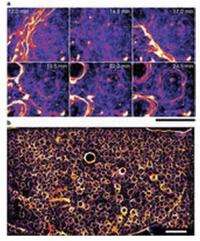March 28, 2012 report
Proteins found to spontaneously form whorls and lattices

(PhysOrg.com) -- Building on the work of a previous team that found filaments made from actin, when combined with so called motor proteins, moved themselves into distinct patterns, a new team in Japan has found that combining different proteins results in the formation of far more elaborate patterns such as individual whorls and over time whole lattices. The team made up of a diverse group of researchers from across Japan, have published their findings in Nature.
This new work is part of a larger effort in the physics community involved in studying the means by which groups of organisms spontaneously move collectively, such as birds in a flock or fish in a school; all appearing to move as if of one mind. But because of the complexity of such large groups, scientists have turned to organisms with the same types of abilities but are much less complex. To that end, some have begun looking at proteins which are able to move and coalesce into patterns on a glass slide which can be watched using a simple microscope.
Recently, one group found that when combining filaments made from actin, with motor proteins, the protein filaments would order themselves into waves or even spirals. This new research shows that such ordering can be far more profound if the right combinations of ingredients are used.
The Japanese team started with a filament called a microtubule, then added a motor protein called dynein. When paired the two join, as if adding a motor to a boat. When the motor protein starts running, fed by ATP, the microtubules are propelled around in a liquid material, like boats on water.
The researchers found that when they created enough of these little protein motor boats in the same pool on a glass slide, they at first seemed to putter aimlessly about, but after time, they soon began arranging themselves into individual whorls. And then, over a longer period of time the whorls began to form lattices. And that wasn’t all; they found by looking closer that individual microtubules were able to move around not just within the individual whorls, but between them, without disturbing either.
The research team readily admit they have no idea how or why the patterns emerge but do believe finding answers to such questions will likely lead to explaining how larger organisms are able to move collectively as well.
More information: Large-scale vortex lattice emerging from collectively moving microtubules, Nature 483, 448–452 (22 March 2012) doi:10.1038/nature10874
Abstract
Spontaneous collective motion, as in some flocks of bird and schools of fish, is an example of an emergent phenomenon. Such phenomena are at present of great interest and physicists have put forward a number of theoretical results that so far lack experimental verification. In animal behaviour studies, large-scale data collection is now technologically possible, but data are still scarce and arise from observations rather than controlled experiments. Multicellular biological systems, such as bacterial colonies or tissues, allow more control, but may have many hidden variables and interactions, hindering proper tests of theoretical ideas. However, in systems on the subcellular scale such tests may be possible, particularly in in vitro experiments with only few purified components. Motility assays, in which protein filaments are driven by molecular motors grafted to a substrate in the presence of ATP, can show collective motion for high densities of motors and attached filaments. This was demonstrated recently for the actomyosin system, but a complete understanding of the mechanisms at work is still lacking. Here we report experiments in which microtubules are propelled by surface-bound dyneins. In this system it is possible to study the local interaction: we find that colliding microtubules align with each other with high probability. At high densities, this alignment results in self-organization of the microtubules, which are on average 15 µm long, into vortices with diameters of around 400 µm. Inside the vortices, the microtubules circulate both clockwise and anticlockwise. On longer timescales, the vortices form a lattice structure. The emergence of these structures, as verified by a mathematical model, is the result of the smooth, reptation-like motion of single microtubules in combination with local interactions (the nematic alignment due to collisions)—there is no need for long-range interactions. Apart from its potential relevance to cortical arrays in plant cells and other biological situations, our study provides evidence for the existence of previously unsuspected universality classes of collective motion phenomena.
Journal information: Nature
© 2012 PhysOrg.com



















